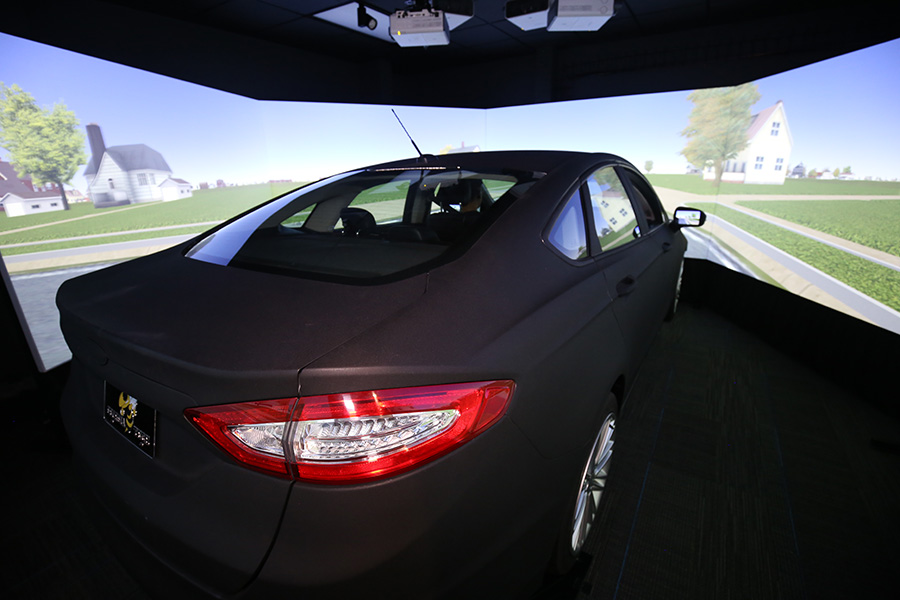When you take a seat in the 2013 Ford Fusion sitting in Srinivas Peeta’s new lab, you enter a virtual world where researchers can throw anything at you: snow and ice, detours, traffic snarls.
All you have to do is drive, and along the way researchers are going to watch every turn, every acceleration, every choice in an effort to unlock new insights into how people behave behind the wheel — and eventually create a better transportation network for everyone.
“In our cars today, we interact with the dashboard and all the other elements in the vehicle that allow us to control it. We have Bluetooth, music, a GPS system, all providing information in real time,” said Peeta, the Frederick R. Dickerson Chair in the School of Civil and Environmental Engineering and a leading scholar in understanding drivers’ behavior.
“Creating a realistic driving experience in the lab that includes all of these distractions increases the level of realism, so we can better understand how people interact with new environments.”
In some cases, Peeta’s team will pair simulation data with the physiological reactions of drivers, tracking eye movement or brain and heart activity while drivers travel through the simulated environment.
“The question we’re asking is, ‘Does additional physiological data allow us to better understand the actions of the driver?’ And if so, how can that be used to better explain what is going on in the context of the travel decisions that they're making?”
 The new driving simulator lab includes this full-size Ford Fusion and two smaller desktop simulators that can interact in the simulated environment. Frederick R. Dickerson Chair Srinivas Peeta and his team will present all kinds of scenarios to test drivers and monitor their reactions in an effort to unlock new insights into how people behave behind the wheel — and eventually create a better transportation network for everyone. (Photo: Candler Hobbs) The new driving simulator lab includes this full-size Ford Fusion and two smaller desktop simulators that can interact in the simulated environment. Frederick R. Dickerson Chair Srinivas Peeta and his team will present all kinds of scenarios to test drivers and monitor their reactions in an effort to unlock new insights into how people behave behind the wheel — and eventually create a better transportation network for everyone. (Photo: Candler Hobbs)
|
Using all of that information, Peeta and his team build analytical models to understand and, eventually, predict traffic patterns so transportation agencies can improve the system — both in terms of how its operated but also how they plan for the future. Plus, their experiments can help vehicle manufacturers design safer and more efficient vehicles that are easy for people to understand and operate — an especially important consideration as autonomous and semi-autonomous vehicles begin to take shape.
“The human, vehicle and infrastructure continuously interact,” Peeta said. “If you change the vehicle technologies, as is happening right now, where we get into different levels of automation and connectivity, that changes the way the driver will interact with the vehicle itself.”
Peeta’s new lab also includes two smaller scale driving simulators — just a couple of computer screens and a steering wheel — that interface with the full-size car. That allows researchers to put several drivers in the same environment and study their interactions.
Eventually that environment will be a virtual Atlanta. The simulator came with a basic city, but Peeta and his students are working to build out a representation of the real thing.
“We cannot [build the transportation systems of the future] in isolation — that is, we just build whatever technologies we want in the vehicle, and whatever infrastructure we want,” Peeta said. “In the end, it is determined by how the humans interact, adapt to, and adopt these new technologies.”
Related
- Srinivas Peeta
- News: “Our autonomous transportation future: New Dickerson Chair Srinivas Peeta and the human-vehicle-infrastructure connections to make that future a reality”
